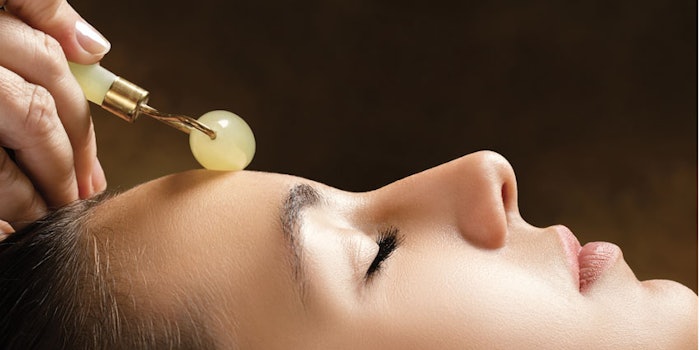
The recent popularity of facial yoga (see sidebar), jade rolling, gua sha facial lifting tools, Ayurvedic Kansa wands, and J- and K-beauty facial massage techniques has shown that the power of touch is front-and-center in consumers’ minds. But how does touch enhance the efficacy and emotional benefits of skin care? Here, Katerina Steventon, Ph.D., takes a closer look. -Editor
Touch is approached differently among various cultures, and a diverse array of massage techniques deliver a different quality of contact and skin-feel to the recipient, ultimately providing the brain with relaxation or refreshmenta. Now, advanced research techniques, e.g., electroencephalography (EEG) and functional magnetic resonance imaging (fMRI), can detect changes in brain wave patterns and different brain area activation, for the first time providing evidence of the effect touch can have on the whole body.
Boosting the Sensory Experience and Well-being
My consultancy promotes touch in skin care applications to enhance the sensory aspects of new products and their impact on consumer well-being. However, one size no longer fits all. Application techniques can only boost the efficacy of daily cleansing and moisturizing if they’re targeted to the appropriate markets and ethnicities and reflect cultural paradigms. In each and every case, expanding the sensory experience of product application should be underpinned by understanding the biology of skin touch and the skin properties of the targeted group including the impact on well-being and self-esteem.
How Touch Enhances Skin Care: Physical & Emotional Results
Skin is the largest sensory organ, acting as our protective barrier between our internal and external worlds. In addition to safeguarding human health by mechanisms such as repairing the stratum corneum to prevent loss of hydration or producing melanin to prevent inflammation due to UV ray exposure, the skin is also a visible emotional envelope. In fact, ongoing research has shown that skin senses external information in the same way that the brain does; it can assess the strength of sound, color and lightb.
I believe that the health and well-being of the body starts with skin barrier integrity, therefore intrinsically linking physical and emotional requirements. Touch can satisfy both needs by boosting skin care product efficacy and generating a wave of positive emotions to make people look and feel well. As a result, application techniques for skin care should be designed to:
- Increase delivery of active ingredients
- Enhance the function of cleansing/exfoliation and moisturization with short massage techniques tailored to specific facial areas to increase blood flow, soothe the epidermis, drain the lymph for optimal condition of the skin, etc.
- Alleviate signs of aging—e.g., sagging, loss of dermal volume, lines and wrinkles—via deeper mechanical stimulation
- Release well-being hormones such as endorphins and improve mental health
- Provide a degree of touch attuned to the specific skin conditions and types, ages and the culture(s) targetedc
3 Steps for Building a Skin Care Routine
1. Consider skin conditions.
The design and modality of each new technique should consider the non-invasive physiological parameters of the skin, i.e., hydration, transepidermal water loss (TEWL), texture and sebum levels.
Particularly for oily, combination and sensitive skin types, touch techniques require a careful design. Consumers often give high subjective assessments of oiliness that don’t correlate with objective measurements of sebum levels. While oily skin is thought to be more resilient, it can be detrimental to the skin barrier and be challenged by its own sebum, as implicated in acne and sensitive skin.
2. Understand the emotional effects.
The application of skin care products create a connection with the consumer through touch, which induces multifaceted neural, hormonal, muscular and mental changes in the user/recipient. Because the skin and brain are connected through our integrated senses, touch creates a powerful feel-good hedonistic effect. Therefore, even gentle touch employed during daily skin care routines makes people feel better.
3. Use a multisensory approach to formulate and communicate benefits.
Touch is much more emotionally colored and subjective than other senses. Therefore, the feeling of touch is difficult to express. As a result, formulators and marketers must appreciate the consumer’s state of mind when creating skin care products, including the need for an olfactory experience to deliver a scent that precedes touch to forge a more complete experience.
In addition, evidence-based routines need to leverage product formats that support the intended type and duration of massage techniques. Remember, touch can only enhance efficacy if skin barrier integrity and product safety is respected.
Finally, marketers must employ imagery and designs that create a deeper appreciation of the product. Critically, the product application technique description should use words that constantly link back the intended skin sensation.
__________________________
Katerina Steventon, Ph.D., founder of the Independent Skincare Consultancy Ltd. (www.katerinasteventon.com), is a skin care scientist and clinician based in the United Kingdom. She has a background in clinical biochemistry, a Ph.D. in transdermal absorptions and a commercial background in wound healing. Steventon approaches skin care by addressing well-being through facial skin concerns related to anti-aging, mild skin barrier dysfunction and acne problems. She is also a thought leader in the area of touch in skin care applications and consults for the industry, as well as private clients.
Footnote:
aA version of this article was presented at the 6th Anti-Ageing Skin Care Conference in London, in June 2018.
b“Tactile input affects what we hear: UBC study”; https://news.ubc.ca/2009/11/26/tactile-input-affects-what-we-hear/
cRecent facial mapping research by DSM—published in a 2015 paper by R. Voegeli et al., “Facial color mapping of stratum corneum hydration of different ethnic groups and the effect of a moisturizer,” and presented at the 2015 IFSCC Conference in Zurich—enhanced the industry’s understanding of facial skin biology. The next step is to understand the different facial touch techniques across different facial zones and cultures in order to ascertain which type of touch to use in each application.











